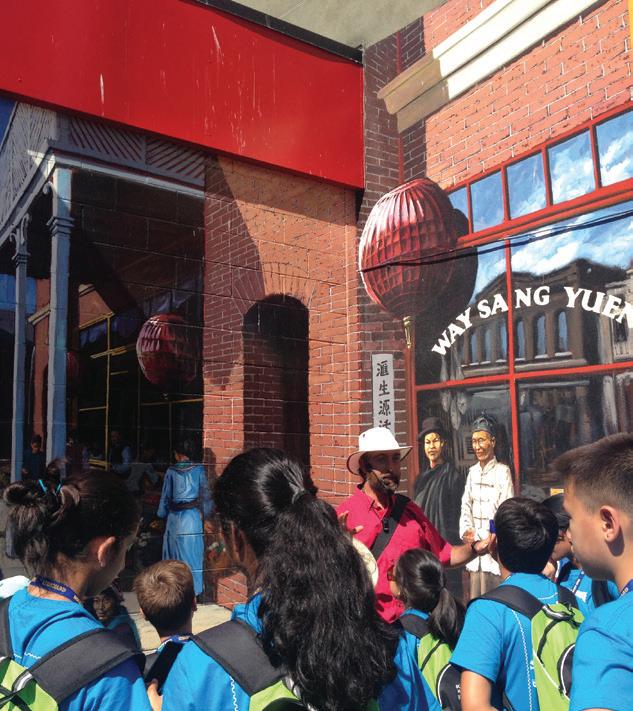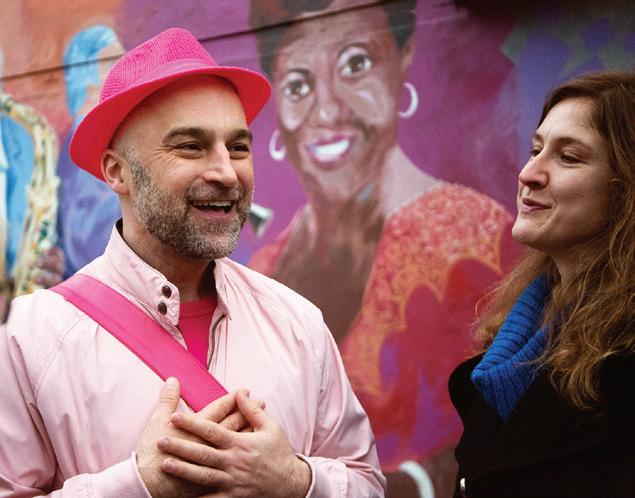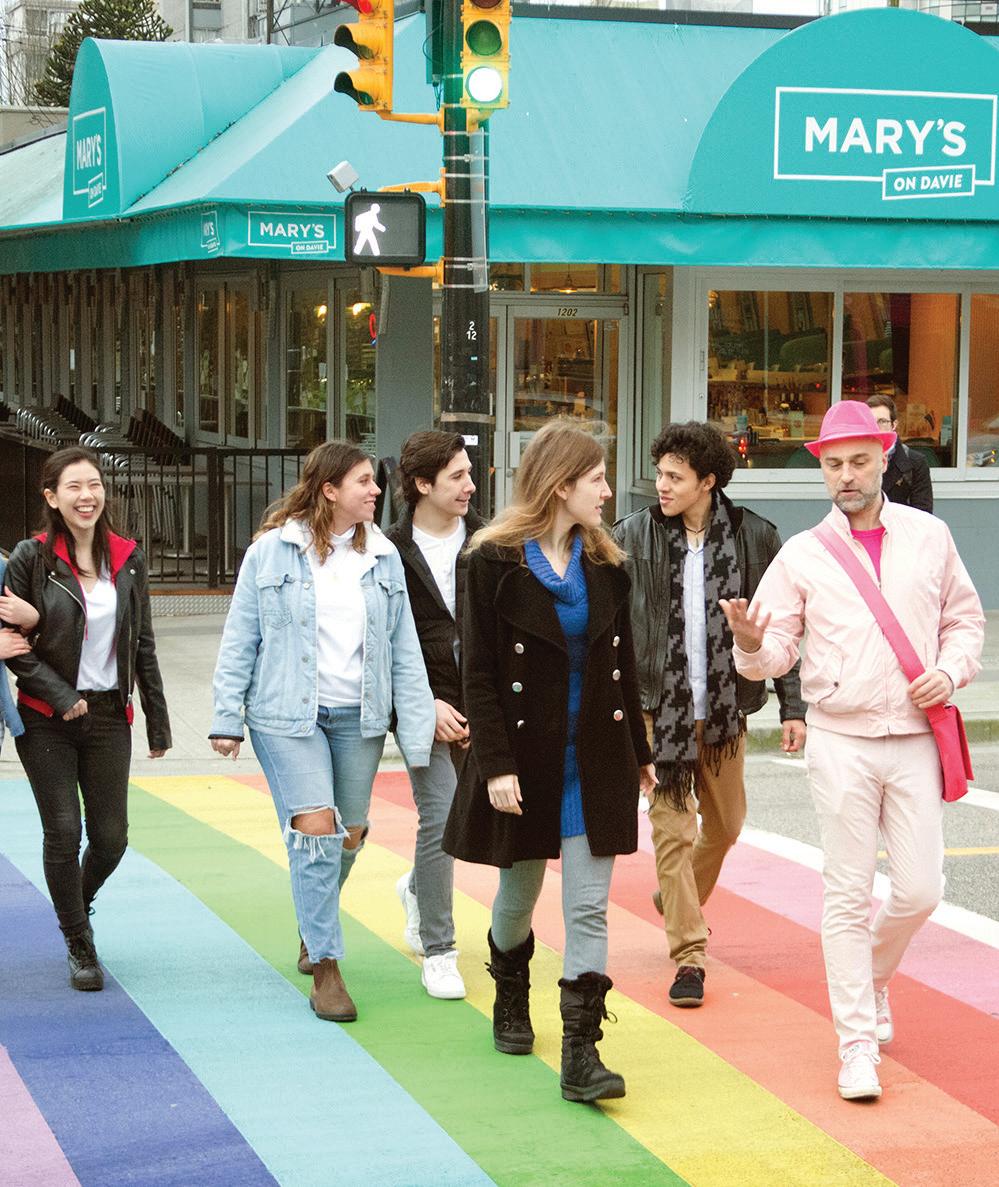
5 minute read
Untold histories
Exploring Community Stories Outside of the Museum
Sarah Carlson
Advertisement
This column explores innovative informal education projects being undertaken within our local museum community. As active spaces for dialogue, connection and critical thinking, it seeks to highlight programming that makes our institutions more inclusive and that encourage more meaningful engagement with our visitors.

Storyteller leads visitors during ForbiddenVancouver’s Lost Souls of Gastown tour.
Sarah Carlson
Whether it is exploring the seedier side of the city’s history with the Vancouver Police Museum’s Sins of the City tours or experiencing the sights and sounds of the Burrard Dry Docks in North Vancouver with the Shipyards Pals Sal and Sam, the ways in which local history and community stories are being shared is shifting, moving from the museum to the streets as a way of connecting with new audiences and removing barriers. The ways in which these place-based stories are explored can take many forms, including walking tours, interpretive panels in the neighbourhood and virtual storytelling through audio and video. These not only highlight untold histories in our community but also provide a platform for previously unheard voices to share their stories and transform our understanding of the current historical narrative.

BC Heritage Fair students learn about the history of Victoria’s Chinatown with Chris Adams of Discover the Past tours.
Sarah Carlson
Companies like Forbidden Vancouver have always operated without brick and mortar as the stories they tell are intricately connected to buildings and places within the community. Offering guided tours that share Vancouver’s rich history with a side of theatre, visitors can step into a world of murder and revenge in Gastown, explore Vancouver’s dirtiest Prohibition-era secrets from mobsters to rum-runners, and discover the jaw-dropping beauty and sinister stories of Stanley Park. The first of its kind for Vancouver, The Really Gay History Tour is Forbidden Vancouver’s newest tour and brings attention to important community stories that are traditionally left out of the historical narrative.

Forbidden Vancouver storyteller Glenn leads guests on The Really Gay History Tour.
Kiri Marr
Researched and developed by storyteller Glenn Tkach, the tour weaves a colourful history of Vancouver’s LGTBQ2+ community and celebrates the successes and struggles of those who fought for acceptance and change. For Glenn, this was a personal passion project and a history that had intrigued him, fuelling his desire to uncover the hidden stories of queer history that he knew had been denied, repressed, buried and erased through the decades. A powerful part of the development process for him was “having the opportunity to sit with individuals who had lived through some of it. Having firsthand accounts of what they experienced and having them entrust him with their personal stories was really powerful.” “Living in the digital age that we do, where we experience things mostly via screen, there is a hunger for this kind of physical experience”, a personal and human and community connection which Glenn believes these tours provide. By teasing these stories out of the historical record and sharing them as part of an live immersive experience allows visitors “to hear about what happened in the place where it happened, to stand at the building where an event or a protest occurred and to imagine it in its own context, which brings a lot of nuances to the story and to the events told.”

Forbidden Vancouver storyteller Glenn Tkach leads guests across Davie Street’s rainbow crosswalk on The Really Gay History Tour.
Kiri Marr
Another way in which the untold stories of our community are brought to life is through self-guided walking tours. Taking advantage of technology that integrates with our mobile devices, like QR codes and iBeacons, recent community video projects like Black Strathcona, Nikkei Stories, South Asian Stories and East End Stories have increased the visibility of local stories within the community. Illuminating rarely told aspects of Vancouver’s history using information panels at key sites throughout the neighbourhood, which contain a QR code that links to a short video. Supported by archival materials, these video clips tell the story of early immigrants, key individuals, like Jimi Hendrix, Hide Hyodo Shimizu, Shushma Datt and David Oppenheimer, as well as the lively social and political history of each area, including the Punjabi Market and Hogan’s Alley. Virtual reality tours, like the 360 Riot Walk, also make use of technology to allow visitors to follow the history in the streets where the 1907 AntiAsian Riots, a mob that attacked Vancouver’s Chinese Canadian and Japanese communities following a demonstration organized by the city’s Asiatic Exclusion League, took place.

Tomekichi Homma, one of the first Japanese immigrants to settle in Steveston, is highlighted on this Nikkei Stories information panel.
Sarah Carlson
While technology will continue to advance and transform the way in which we are able to engage with the intersection of place and history, the core of any programming highlighting untold community stories will always be making connections to the important places and personal stories of those who have shaped our history. By providing a broader understanding of neighbourhood or building, these programs also bring awareness to the details that form the layered, complex story of an area and enable visitors to forge personal connections to the history through the use of compelling stories from members of the community.

Named after the Chinese gambling game, Fan Tan Alley in Victoria was once home to a gambling district with restaurants, shops, and opium dens.
Sarah Carlson

SARAH CARLSON
Sarah Carlson is the acting Educational Program Coordinator for the Richmond Museum and has been a member of the LMME Conference Committee since its inception in 2016. She has a Masters of Museum Studies from the University College of London and has previously worked at the Museum of Anthropology and the Delta Museum and Archives.








